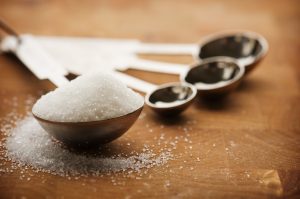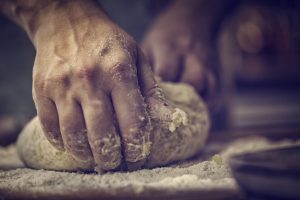People use the word “sugar” to describe a variety of things. Often this word refers to sucrose, sometimes to granulated white sugar or common table sugar, which is a substance made from beets or sugarcane.
The easiest way to understand how various sugars differ from one another as it applies to baking is to start with chemistry.
Eventually, all carbohydrates in a human body break down into glucose. However, this doesn’t mean that sugars are a primary food source because other than being fuel, sugar does not offer any other nutritional value for the body.
Nutritionally speaking, humans need 6 food elements for survival. These elements are water, fats, proteins, carbohydrates, minerals and vitamins. Sugars are a subset of carbohydrates. Technically, when a number of sugar molecules join together in a chain, they stop being sugars and become starches. This means that sugars can be building blocks for more complex carbohydrates. For this reason, sugars not only have an impact on the sweetness of baked goods but can also influence their physical properties.
Browning
Sugar that is present along a hot surface starts to caramelize. This is true not only about baked goods, but also sugars in fruits, vegetables, and other foods. This is why sugar of any type will have an impact on the color of the crust.
Aeration
All granular sugars will aerate a batter when mixed into a cream with a solid fat such as butter. Aeration is critical in many baking recipes. If you want to expand the air bubbles, you can also add chemical leavens, including baking powder. This being said, a creamy mixture of granular sugars and fats is the most effective way to obtain a light product with an even texture
Tenderness
Sugar competes with starches and proteins in batters in doughs for water. This means that it interferes with the creation of gluten and can make a product tenderer.
Retention of Moisture
Sugar allows baked goods to retain moisture longer. A product that contains sugar will stay fresh longer than a product without sugar. This is true for all kinds of sugars, including honey and corn syrup. In addition to retaining moisture, fructose attracts moisture from the environment. This is why cakes with a lot of honey in them can stay fresh for a very long period.
At the same time, moisture retention qualities of sugar mean that if you are making candy, then hot, rainy and humid days can be detrimental to the process. Hard candies like toffee will become sticky and chewy if you keep them in a moist room during the cooling stage.
Fermentation
Small amounts of sugar in dough speed up the fermentation of yeast. The opposite is true when the dough has a lot of sugar in it. In this case, sugar will slow down the fermentation process significantly.
